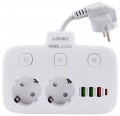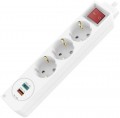Cable length
The length of the cable used to connect the surge protector to the network.
The longer the cable, the farther from the outlet you can install the device. On the other hand, a long cable can be inconvenient over short distances. Models on a coil are deprived of this drawback (see "Type"), this moment is compensated by the actual presence of the coil, but they differ in large dimensions and heavy weight. So when choosing, it is far from always worth chasing the maximum length of the wire.
Max. power
The highest power consumption of the connected devices that the surge protector can tolerate without consequences (to be more precise, with which it can work indefinitely without overloads, overheating, etc.).
This limitation is due to the fact that the higher the power at the same voltage, the higher the current passing through the equipment (in this case, through the surge protector); and off-design currents can lead to breakdowns and even accidents. And although in order to avoid these consequences, modern filters often provide various types of protection (see above), however, the operation of protection is still an emergency situation that is best avoided. Therefore, it is worth choosing a model according to this parameter in such a way that the maximum filter power is at least not lower than the total power consumption of the load. And it is best to have a margin of 20 – 30% — this will give additional guarantees in case of various deviations in the operation of the connected equipment.
Separately, it is worth highlighting the situations when the filter is planned to be used for the so-called reactive load — electrical appliances that widely use circuits on capacitors and/or inductors, for example, power tools or refrigeration units. The total power consumption of such devices (written in volt-amperes) can be much higher than the active power (which is indicated in watts). The recommended line filter power in such cases is calculated using special...formulas that can be found in the relevant sources.
Max. load
The maximum current that the surge protector can pass through itself for an unlimited time without the risk of overheating, breakdowns and other troubles.
This parameter is directly related to the maximum power of the filter (see above): power is the current multiplied by the voltage. Thus, for example, for a standard 230 V model with a maximum power of 2200 W, the maximum load will be 10 A. Note that the characteristics of modern filters may not correspond to such calculations — for example, the same 10 A can be claimed for a 2500 W model . However, this is not something extraordinary: the difference in figures may be due to active and reactive power (see "Maximum power"), the characteristics of single-phase filters (without 400 V sockets, see above) can be given both for 230 V, so for 230 V and even 240 V, figures may be rounded for readability, etc.
Anyway, the practical value of the maximum load is the same as the maximum power: it should not be less than the current supplied to the connected electrical appliances (otherwise the protection may trip, or even break). And they use this parameter, along with the maximum power, because in some cases it is easier to evaluate the characteristics of the load (and filter requirements) in terms of current consumption, and not in terms of power.
Wire section
The cross-sectional area of the wire used to connect the filter to the network. The larger the cross-sectional area, the thicker the wire, the more reliable it is and the more current it can pass without overheating. Accordingly, thick wires (
1.5 mm² and
2.5 mm²) are a must for high power devices. At the same time, modern manufacturers, usually, choose the cross-sectional area in such a way as to guarantee the safe operation of the filter at the claimed maximum power (see above). Therefore, in fact, a model with a thicker cable than other similar devices should be chosen if it is supposed to be used in unstable networks in which power surges often occur. If the cross-sectional area seems too small for you (
0.75 mm² or
1 mm²) for the claimed power, there are special formulas that allow you to check the validity of such doubts.
Operation indicator
The presence in the design of the surge protector of a special indicator (usually in the form of a light bulb) that indicates that the device is turned on.
This function provides the presence of at least one common indicator; and on models with switches per outlet (see below), additional indicators can be installed on the outlets. Anyway, such equipment makes working with the surge protector more visual, allowing you to immediately assess the status of the device and avoid some unpleasant situations (for example, imaginary equipment breakdowns — when a “faulty” device does not work just because the filter is not turned on).
The indicator can be installed directly in the switch (general or for each outlet, see the relevant paragraphs for details).
Power switch
—
Switch on the body. This function allows you to turn off the power to the load without disconnecting the filter itself from the mains — in other words, it eliminates the need to once again remove the filter plug from the outlet and insert it back. Most often, the switch controls all filter outlets, however, there are models where some of the connectors are bypassed and are always energized, regardless of the position of the switch.
—
A switch for each outlet. This feature makes it easier to manage the power of connected devices: unplugging and plugging individual outlets is usually easier and faster than unplugging and plugging back in. Thus, electrical appliances used with such a filter can be kept constantly connected to it, turning off and on individual outlets as needed.
— Switch for each circuit. The function is used in models with numerous outlets. Allows you to simultaneously disable half of them, leaving the rest working. It combines the convenience of the points listed above and at the same time does not clutter up the device with unnecessary switches.
It is also worth noting that there are models that combine both a switch on the case and a switch for each outlet.
Grounded sockets (type F)
The number of
sockets with type F grounding, provided in the design of the mains filter.
In this case, we are talking about full-size European type F sockets with metal ground clamps on both sides at the edges of the socket. The "socket" in this case means a CEE 7/4 ("Schuko") standard plug. Grounding is required for the safe operation of some types of electrical appliances, in particular, washing machines and other machines that work with water, refrigerators, computers, audio equipment, etc. A detailed list can be found in the reference literature. If you plan to connect such devices through the filter, this filter must have sockets with grounding.
USB A
The number of
USB ports for charging, provided in the design of the surge protector.
Such ports do not perform any other function than powering and charging external devices such as smartphones or tablets. The presence of such connectors in the surge protector can be especially convenient when there is no “230-to-USB” adapter at hand, and there are few USB ports in a computer or laptop and using them for charging is “an unaffordable luxury”.
Max. charging current
The current output by a USB connector when a charging gadget is connected to it.
The higher the current, the faster the battery can charge. However, when choosing, note that in order to use a high current strength, the connected device must also support it. Basically there are
USB with a current strength of 2.1 A,
2.4 A and
3 A.
It is also worth noting that when using several USB ports at the same time, the current strength is significantly reduced.

